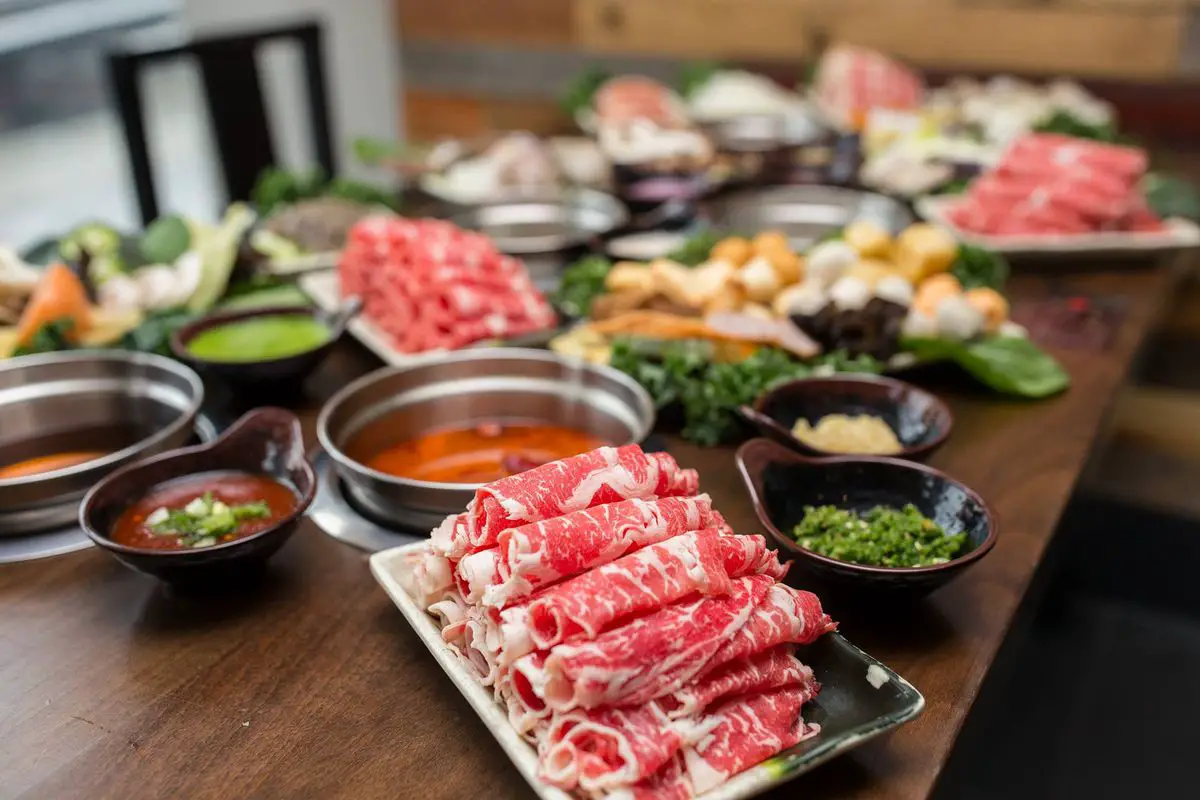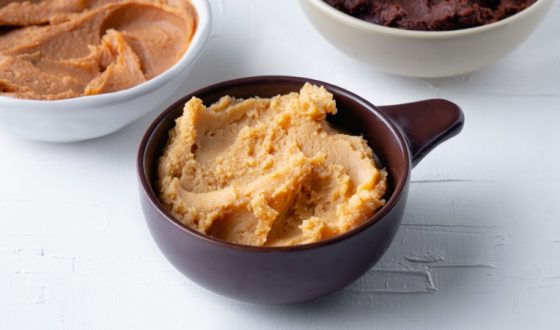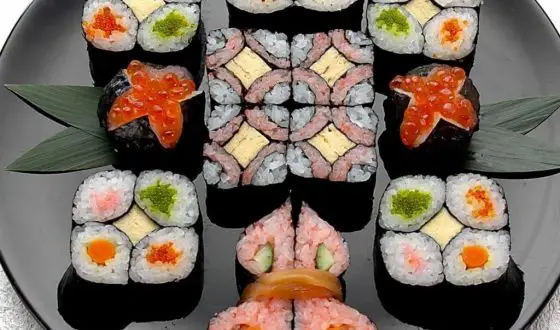The 5 Most Popular And Easiest Japanese Hot Pot Recipes
If you come to Japan in winter, you will find out that the common way to keep warm here is to gather around for nabemono, the Japanese hot pot. It is basically the dish in which the broth or sauce is kept simmering at the dining table. You may cook the ingredients like meat, vegetables, tofu … in advance or add them later throughout the meals. Besides, you may eat the cooked food with the broth or with a dip. There are various versions of this dish across the country that takes a lifetime to master them all. So let’s narrow it down and take a look at these following delicious Japanese hot pot recipes:
1. Sukiyaki – Sweet flavor
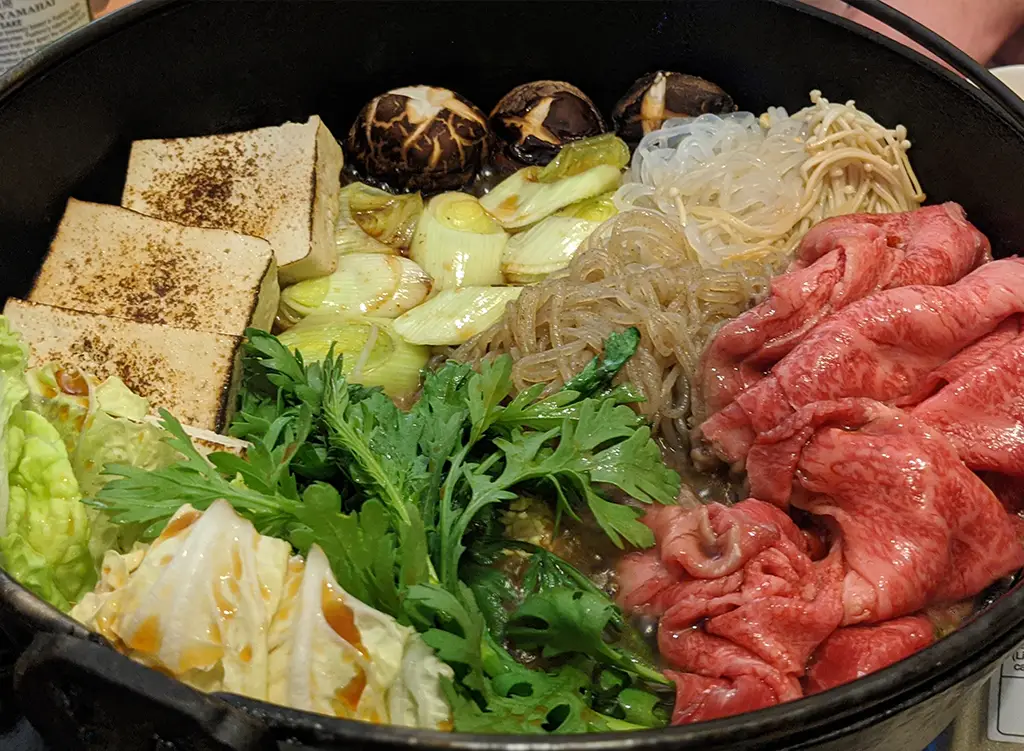
Sukiyaki is a popular Japanese hot pot dish that is often cooked and served at the table, similar to Shabu Shabu.
SEE MORE:
Traditional Japanese Food: The Best Dishes You Must Try
Best Japanese Fast Food To Try
Sukiyaki (すき焼き) is a Japanese hot pot winter dish which is typically served during the end of the year meals (bōnenkai). The star of the dish is meat, commonly slowly simmered sliced beef (ribeye). Other must-have ingredients are mushrooms and vegetables. Furthermore, the uniqueness of the dish the raw, beaten eggs dip which is tastier and less scary than foreign people thought.
Recipe (2 persons)
Sukiyaki Sauce
- 1 cup of soy sauce
- 1 cup sake
- 1 cup mirin (Japanese sweet rice wine)
- 1/4 cup sugar
Main ingredients
- 1 package soft tofu or ½ pound
- 10 scallions including green tops
- 1/2 pounds ribeye steak (you can find pre-sliced beef for Sukiyaki package at any grocery store in Japan)
- Leafy vegetables: 1/2 pound napa cabbage, 1/2 pound shungiku (tong ho in Chinese)
- Mushrooms: 1/4 pound shiitake and 1 package enoki
- 1/2 pound shirataki noodles (yam noodles)
- ⅓ carrot (optional)
- Udon (optional)
- 3 tablespoons cooking oil
- Raw eggs (optional)
Note: You can replace shirataki noodles with vermicelli and shungiku with spinach.
Step by step guide
Step 1: Make the Sukiyaki Sauce
To start with, simply mix the ingredients for the Sukiyaki Sauce, including sake, mirin, sugar, and soy sauce; then boil them in a saucepan with medium heat. However, you should make sure the sugar dissolved completely before turning off the heat.
Step 2: Prepare the main ingredients
- Remove large leaves and wash the vegetables along with other ingredients
- Slice the beef (1/8-inch thick), the tofu (½-inch thick), napa cabbage (1-inch length), shungiku (2-inch peaces), scallion (1-inch lengths), shiitake mushrooms (take the stem off), enoki mushrooms (only discard the bottom part or slice in half), carrots (stamp them into floral shape)
- Soak the dried shirataki noodles in water for 10 minutes.
- Unfrozen udon by boiling it in 3 minutes, then rinse with colda water before draining
Step 3: Cook
- The best way to cook sukiyaki is at the dining table where you place a cast iron pot on an electric skillet. First, add the cooking oil. When it is hot, fry the scallions (only white parts) until the smell becomes clear, you add the beef with some drizzle of your sukiyaki sauce. The perfect cooked beef will be a little pink but mainly light brown.
- Poor the rest of the sauce we made before and 1 cup of water.
- Place all the main ingredients in the pot (except udon)
- Stew approximately 5-7 minutes, then enjoy the meal. (The Japanese will dip the food in a small bowl of raw, beaten eggs, then eat.)
- Eat the udon last.
2. Shabu Shabu – more savory and less sweet flavor
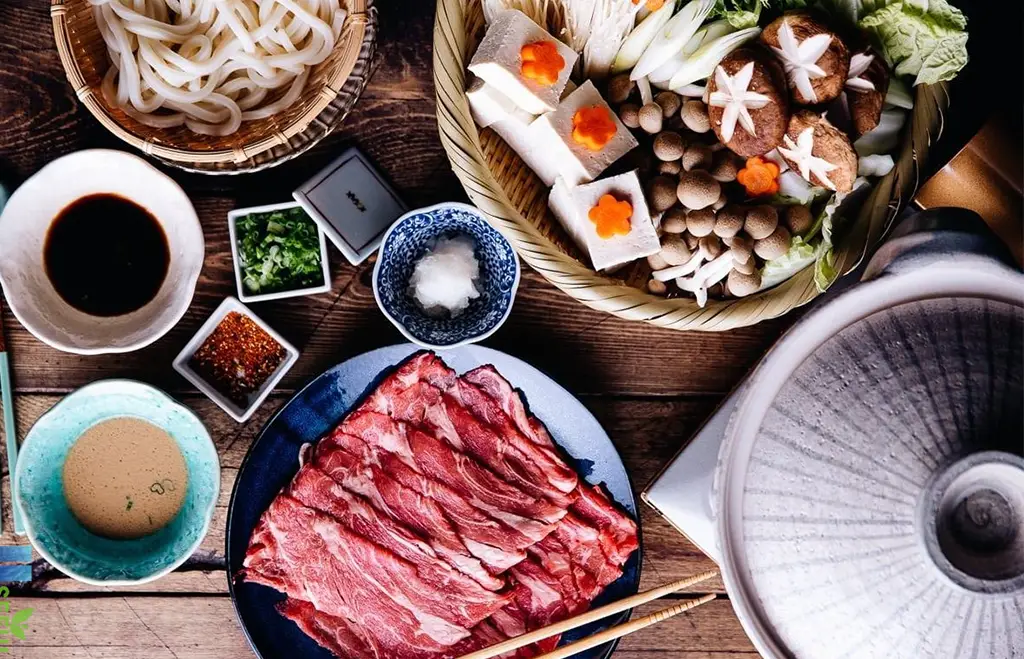
Shabu Shabu is a Japanese nabemono hot pot dish of thinly sliced meat and vegetables boiled in water and served with dipping sauces.
Shabu shabu is one of the popular Japanese hot pot recipes, also staring paper-thin beef and fresh vegetables. But it is much more savory compared to sukiyaki. Why? You will find out in the recipe below:
Recipe (2 persons)
Broth Recipe:
- 1/2 kg pork ribs, chicken cubes or dashi powder
- chopped onions, sliced ginger, lemongrass, star anise, cinnamon sticks & cloves (optional), chili oil salt & pepper
Main ingredients
- 1 package udon noodles
- Leafy vegetables: 1/2 pound napa cabbage, 1/2 pound shungiku (Tong ho in Chinese)
- 1 Negi (long green onion)
- Mushrooms: 1 package enoki mushrooms, 1 package shimeji mushrooms, 1/4 pound shiitake
- 1/4 carrot (optional)
- 1 package tofu
- 1/2 pounds thinly sliced beef (chuck or rib eye)
To Serve
- 1/4 daikon
- 2 scallions
- Sesame Sauce
- Ponzu
Step by step guide
Step 1: To Prepare Broth
Get a large pot and pour 4L water. Then add pork ribs or chicken in water for no l 30 minutes. If you use dashi powder, boiling on high heat in 10 minutes is enough. Don’t forget to add the rest of the ingredients for the broth.
Step 2: To Sesame and Ponzu Sauce them around in the broth.
While you’re waiting for the food to cook, prepare your dipping sauces. Add grated daikon, shichimi togarashi, and green onion in ponzu, and green onion in sesame sauce.
Step 3: To Prepare Ingredients
- Prepare udon noodles according to the instructions. Put frozen udon in boiling water and reheat for 1 minute, then transfer to iced water to stop cooking with remaining, and drain well. Serve on a plate and set aside. Finally with the udon, if you purchased frozen, you can place in a bowl and pour boiling water over them to loosen and thaw out. Then drain and pop in a bowl, placing it alongside the meat and vegetables
- Cut the vegetables as we mentioned in sukiyaki. To put it simply, chop it to a suitable size for you to easily eat later.
- Take the bottom of shiitake, enoki, and shimeji
- Slice the tofu into squares (2cm)
- Cut the white part of negi diagonally into ½ inch (1.3 cm) thick pieces.
- Peel daikon and grate using a grater. Squeeze grated daikon gently and put in a small bowl.
Place everything on one plate and move next to the shabu shabu pot ready for cooking.
Step 4: To Cook Shabu Shabu
- Firstly, set a portable gas burner and put the donabe on the stove. Place platters with ingredients on the table. Give each person a ponzu sauce and sesame sauce.
- Secondly, bring the broth to a simmer over medium heat. Nevertheless, remember to take out the kombu right before water starts to boil (otherwise, the water gets slimy).
- Lastly, add the tofu, the tough part of napa cabbage and shungiku, negi, carrots, and some mushrooms. However, You don’t have to put all the ingredients and cook in batches. Last, cover to cook for 10 minutes.
Step 5: eating
Take out the cooked beef and vegetables from the pot when they are done, and dip the food in ponzu or sesame sauce.
3. Nabeyaki Udon
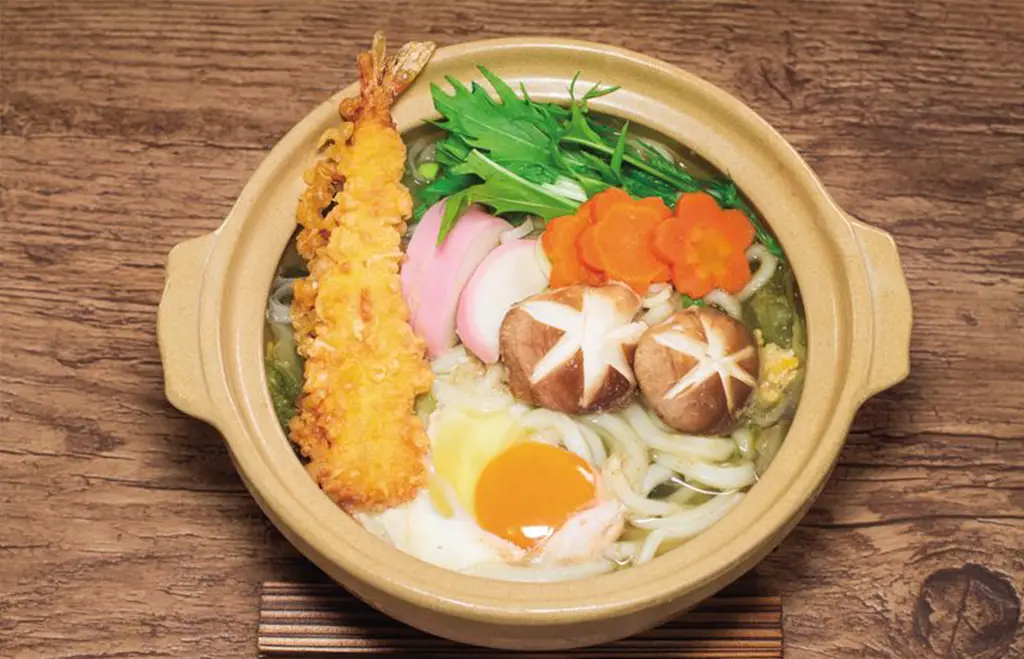
Nabeyaki udon is a traditional Japanese dish consisting of thick udon noodles and vegetables that are cooked in a flavorful dashi stock and served with various toppings.
A sort of udon hot-pot, with seafood and vegetables cooked in a nabe, or metal pot. For instance, the most common ingredients are tempura shrimp with mushrooms and an egg cracked on top.
Recipe (2 persons)
For Udon Soup
- 3 cups (720 ml) dashi
- Dashi from dried shiitake mushrooms
- 2 Tbsp. mirin 1
- 1/2 Tbsp. soy sauce
- 1 tsp. salt
For Shrimp Tempura
- 2 large shrimp 25 g (0.9 oz)
- tempura batter mix 40 ml (about 3 Tbsp.)
- Potato/corn starch for dusting
Step by step guide
Step 1: Make the sauce
- Slice Tokyo negi
- Add liquid from the mushroom
- Add mirin, soy sauce, salt
Step 2: To Prepare Ingredients
- Soak shiitake mushroom for 15 minutes, squeeze water from mushroom and remove the stem.
- Keep dashi from mushroom for later
- The, score a cross on top of the mushrooms
- Blanch spinach for 1 minute, then soak in ice water, cut in 1 ½ inch piếc
- Slice kamaboko, then cut mushrooms
- Cut chicken into 1-inch pieces
Step 3: Make Shrimp Tempura
- Sprinkle corn starch on top of the shrimps
- Dip the shrimp in tempura batter, then fry them in 3 minutes
Step 4: Cook
- Firstly, boil udon noodles, soak in ice water
- Secondly, place udon and ingredients inside nabe. Add udon soup
- Thirdly, boil the nabe, and skim the scum from soup
- At the last stage, you may add the raw egg and spinach and tempura,
4. Kimchi Nabe
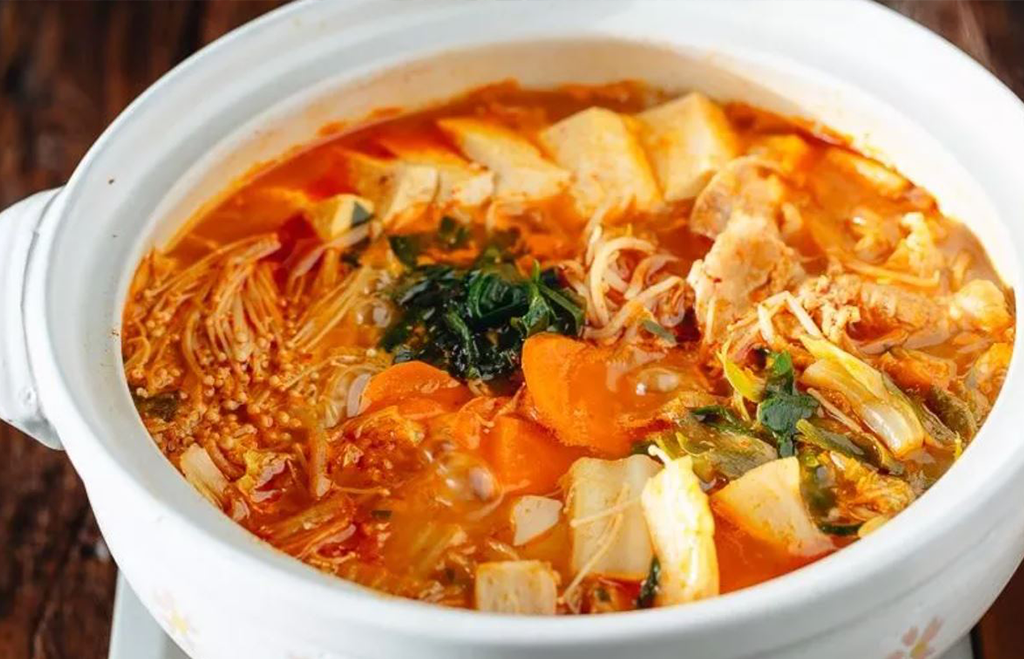
Kimchi Nabe is a hot pot dish popular in winter in Japan
Recipe (1 person)
- 1-1/2 cup water
- 1/2 cup Kimchi soup
- 1 cup Kimchi Chopped
- 1 tbsp garlic
- 1 tbsp Miso
- 1 tsp. gochugaru (Korean Red chili pepper flake)
- 1/2 onion Couple greens such as Spinach, Kale or Bokchoy
- Assorted mushrooms
- 1 green onion 1/2 cup tofu
Step by step guide
Step 1: Prepare the ingredients
Step 2: Make the sauce
- First, add about one and a half cups of water and also a couple of pieces of dashi. Just let the dashi soak in the water for about five to ten minutes before turning on the heat.
- Turn on the heat to about medium-high, add one tablespoon of the miso paste, 1 tablespoon of gochugaru, and one tablespoon of minced garlic after dissolving the miso past.
- Lastly, add ½ cup kimchi broth
Step 3: Add ingredients
- Firstly, add kimchi. (Tip: when you’re making kimchi stew or kimchi fried rice it’s always a better idea to use ripened kimchi.) Let the kimchi boil for about ten minutes under medium to low heat
- Then add any types of greens such as spinach or kale. Add bok choy and also some onions if you like a little bit of sweetness
- Lastly, add a couple of different variety of mushrooms, green onions and some tofu
5. Mille-Feuille Nabe
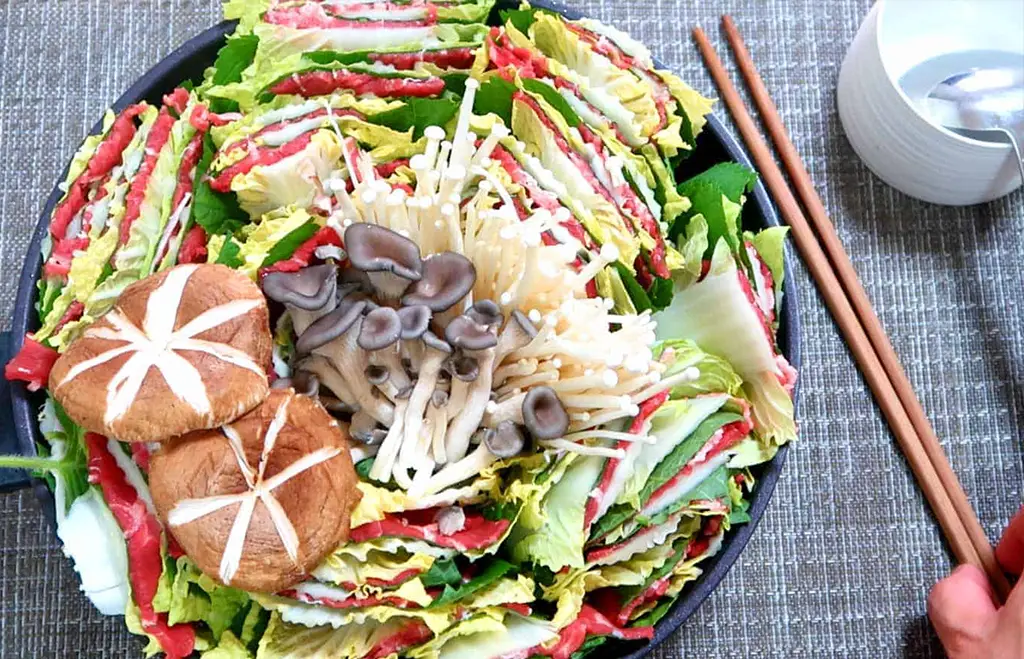
Mille-Feuille Nabe
Recipe (2 people)
- 1/2 pounds ribeye steak
- Vegetables: 1 Cabbage, ¼ pound Perilla Leaf, ¼ pound Bok choy
- Mushroom: ¼ Beech Mushroom, 1 package Enoki Mushroom, 3 shiitake mushroom
- Seafood Stock: 10 Anchovies, 1 kelp, 1/8 pound Radish,
- Dipping Sauce: 1Teaspoon Cooking Wine, 2 Teaspoon Soy Sauce, 1 Teaspoon Vinegar, 1/2 Teaspoon oligosaccharide, 1Teaspoon Sugar, 1Teaspoon Garlic, ground Onion, Minced Hot Pepper
Step by step guide
- Firstly, combine all broth ingredients into a large pot and boil for 10 mins. Remove dashima (kelp) pieces and boil for another 10 mins. Then, season the broth with soup soy sauce
- Secondly, place bock choy on the bottom of the nabe pot. Next, stack layers of Napa cabbage leaf and beef and cut them according to the height of the pot.
- Thirdly, place mushrooms in the middle of the pot, gently pour broth up to 2/3 of the pot.
- Lastly, dip the layer of beef and Napa cabbage after they are fully cooked. Moreover, add sweet chili sauce to your preference. Once you have eaten all the beef and vegetables, you may add noodles or make porridge with rice.
Watch the details here:
FAQs:
What is the Japanese hot pot called?
It is called Nabemono (鍋物, なべ物).Nabe means “cooking pot” and mono is “thing” in Japanese. It basically means “things in one pot” in Japanese. So nabemono not only refers to the hot pot but also one-pot dishes.
What is Japanese hot pot cooking?
Japanese hot pot is typically cooked or at least eaten hot at the dining table by portable stoves with a pot. The traditional pots are called donabe (clay pot) or tetsunabe (thick cast iron). Furthermore, the dish uses flavored broth or sauce. The main ingredients include meat, mushrooms, vegetables, … In fact, these ingredients normally be successively added to the pot and then removed accordingly.
What meat is used in hot pot?
This depends on which version of nabemono you intend to cook. In sukiyaki and shabu shabu, thinly sliced beef (ribeye) is the most popular. In Chankonabe or Sumo wrestlers hot pot, both meatballs and chicken are used. But in modern Japan, people are free to pick the meat they like, ranging from pork, lamb to duck.
What’s the difference between sukiyaki and shabu shabu?
Many people mistake Shabu Shabu for Sukiyaki since they have a lot in common regarding the ingredients and cooking methods. However, Shabu Shabu is usually cooked in a Japanese clay pot (donabe) instead of a cast-iron pot, and the beef is sliced a little more thinly. While in Sukiyaki, you dip food in raw beaten egg, Shabu Shabu provides you with 2 other types of sauce. The most significant difference is in terms of favor. Because of its sauce-based sauce with mirin then Sukiyaki is famous for its richness and sweetness. In contrast, using broth, Shabu Shabu brings about light and savory flavor.

